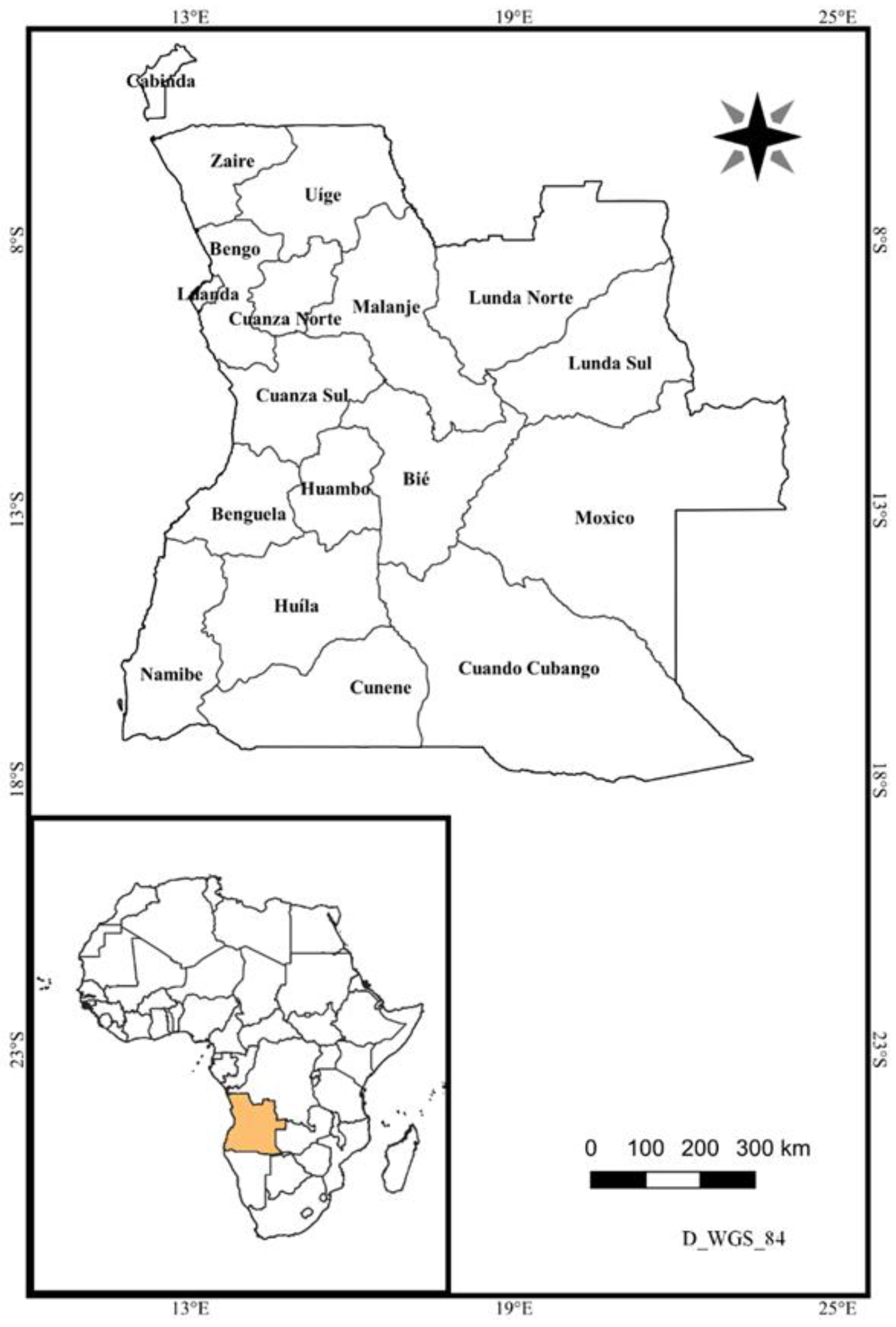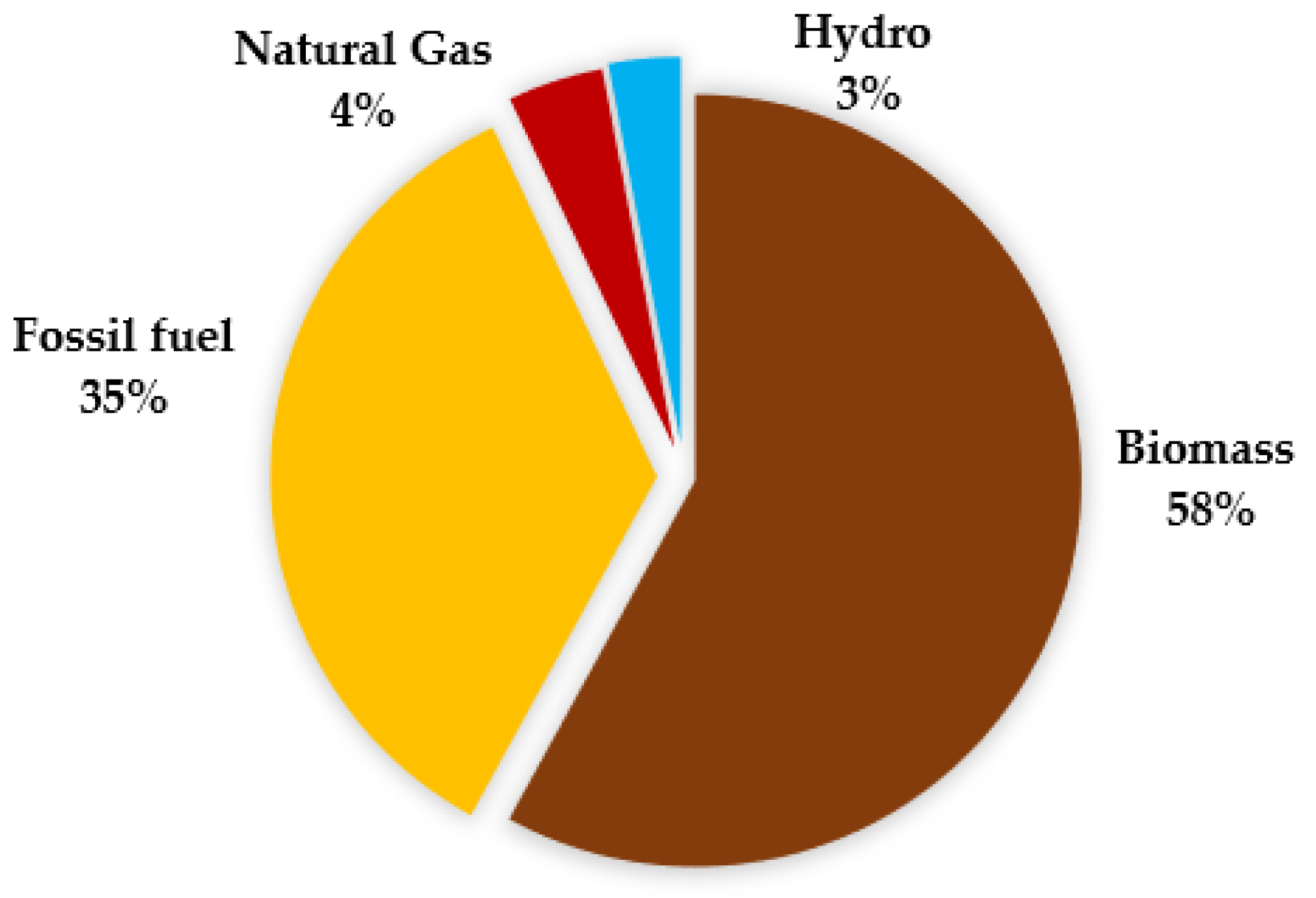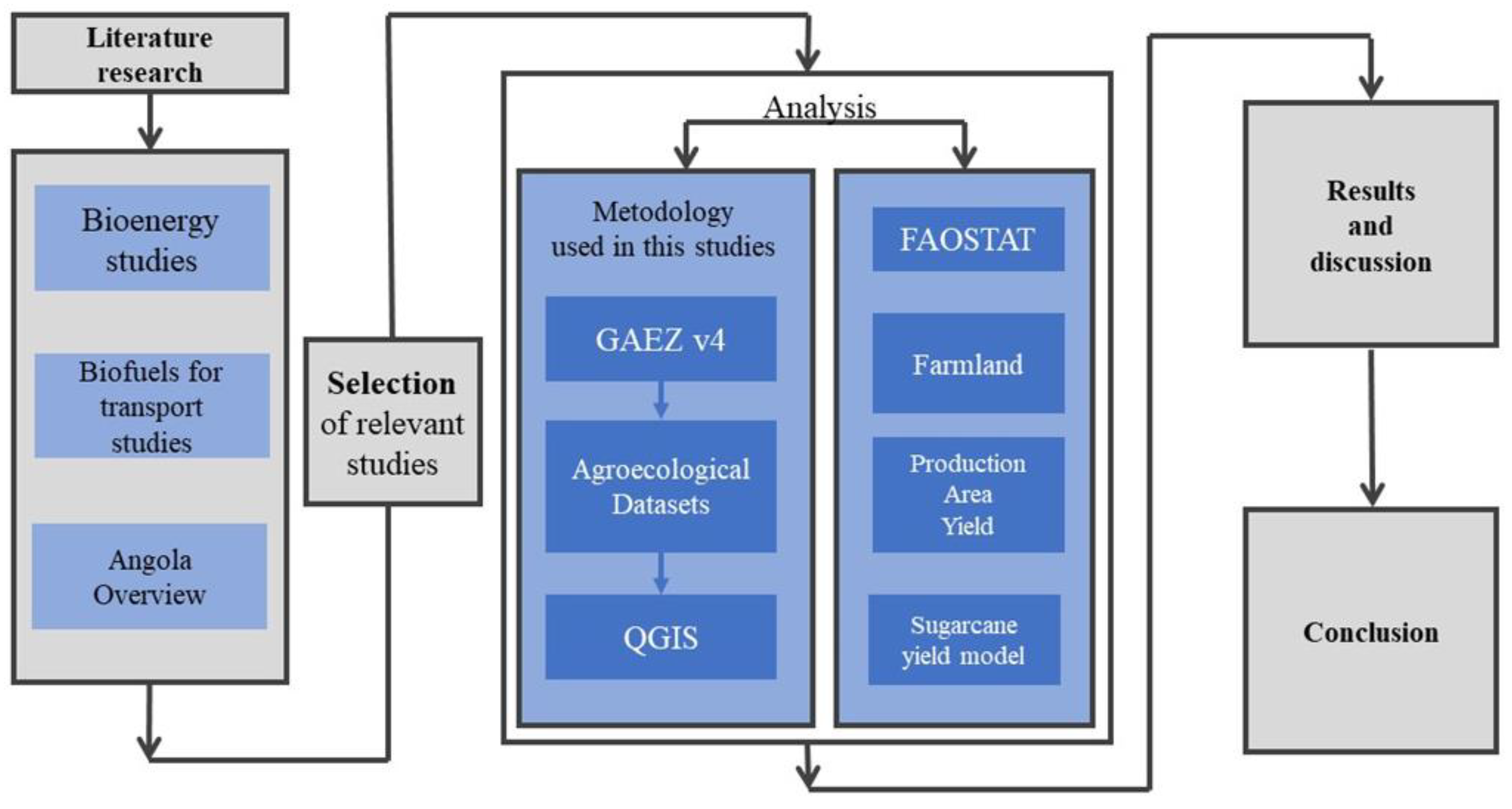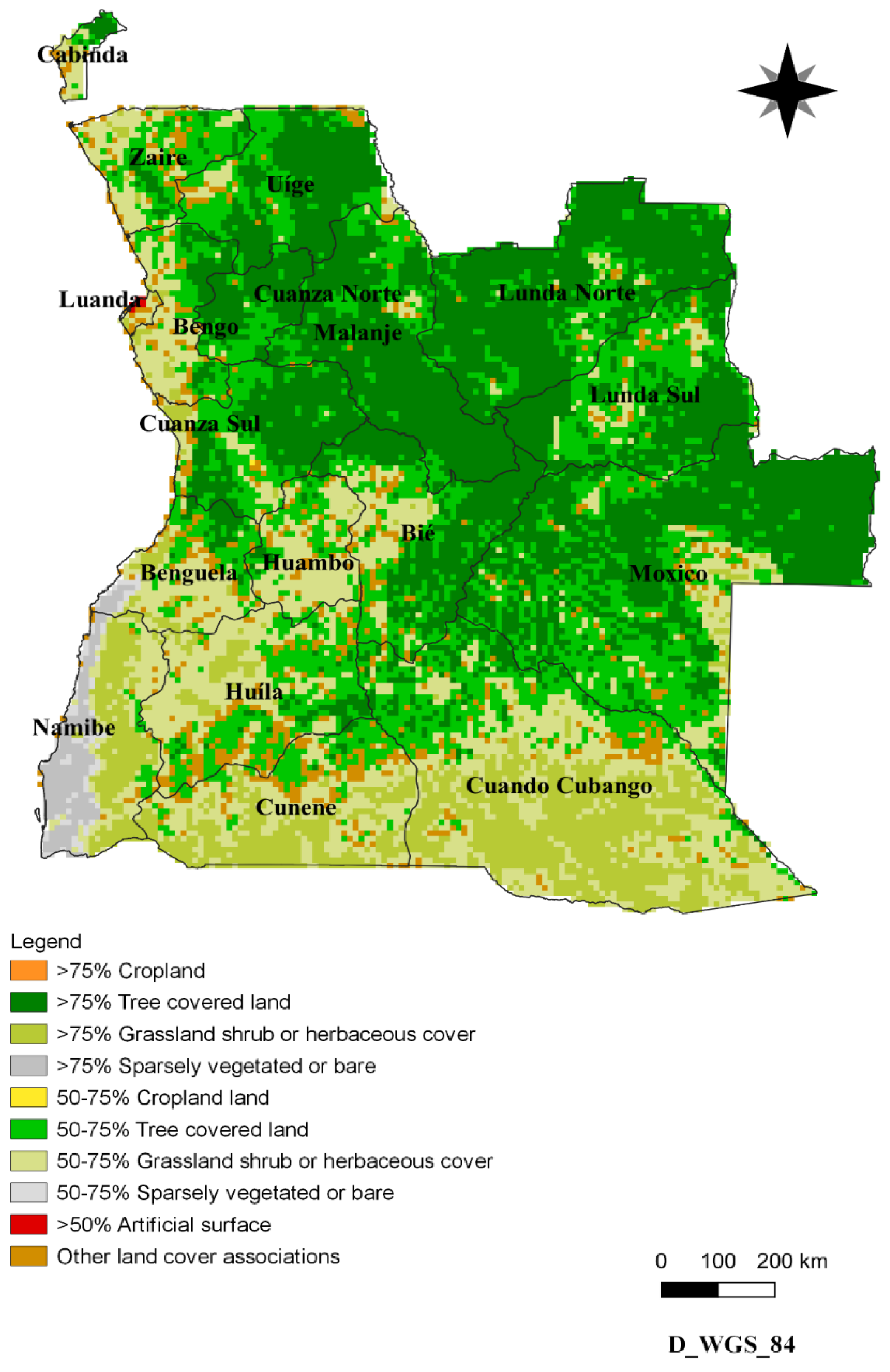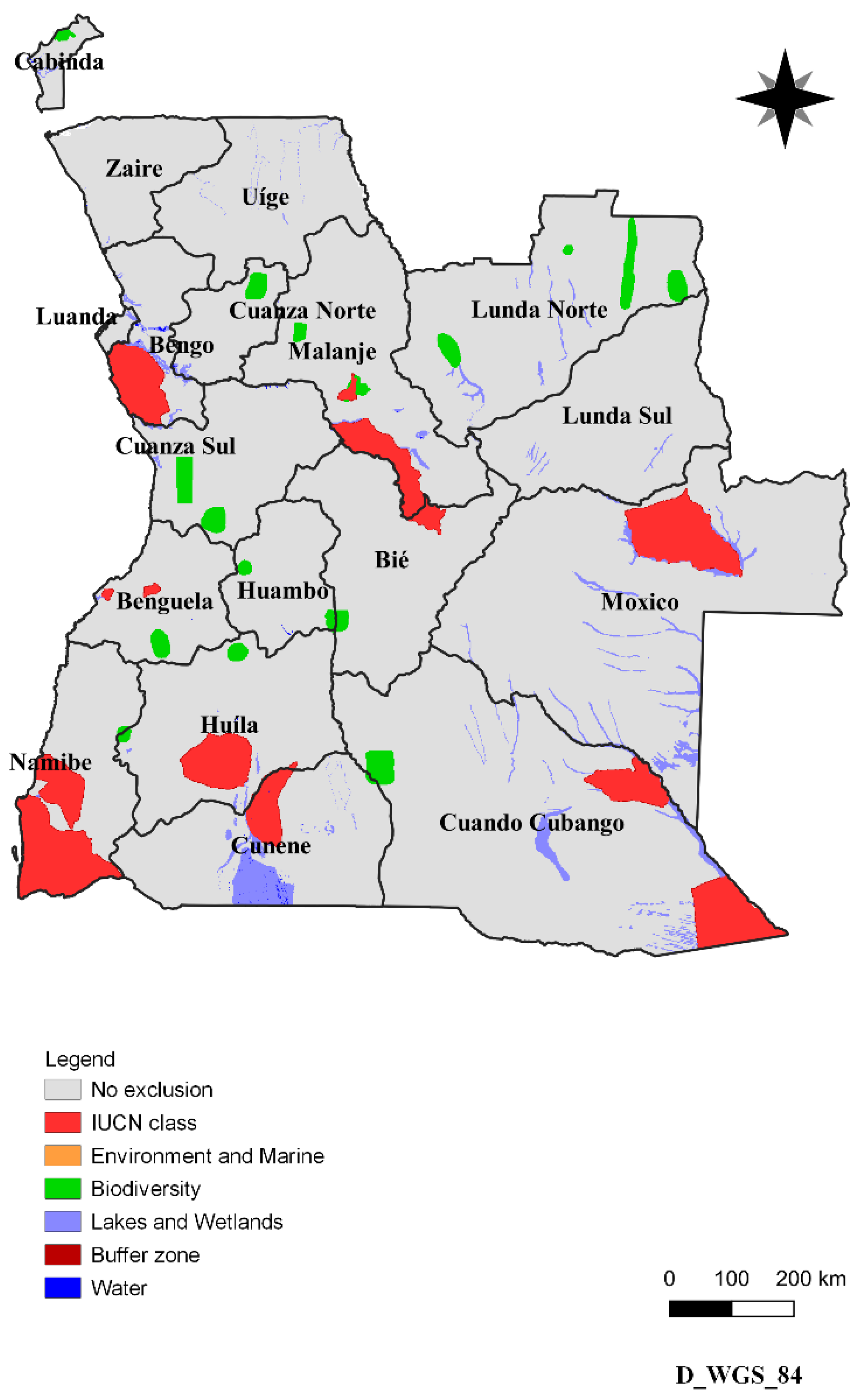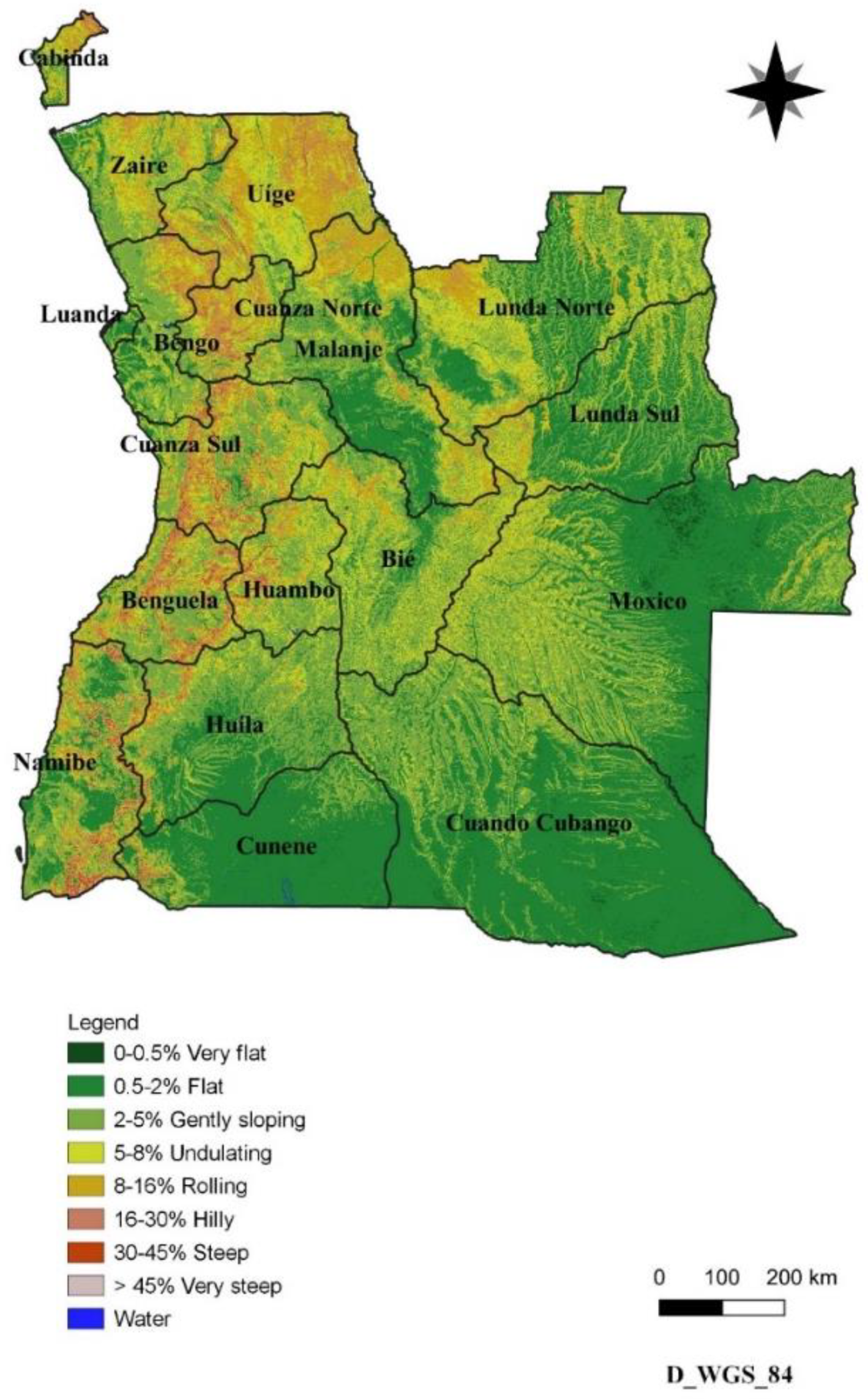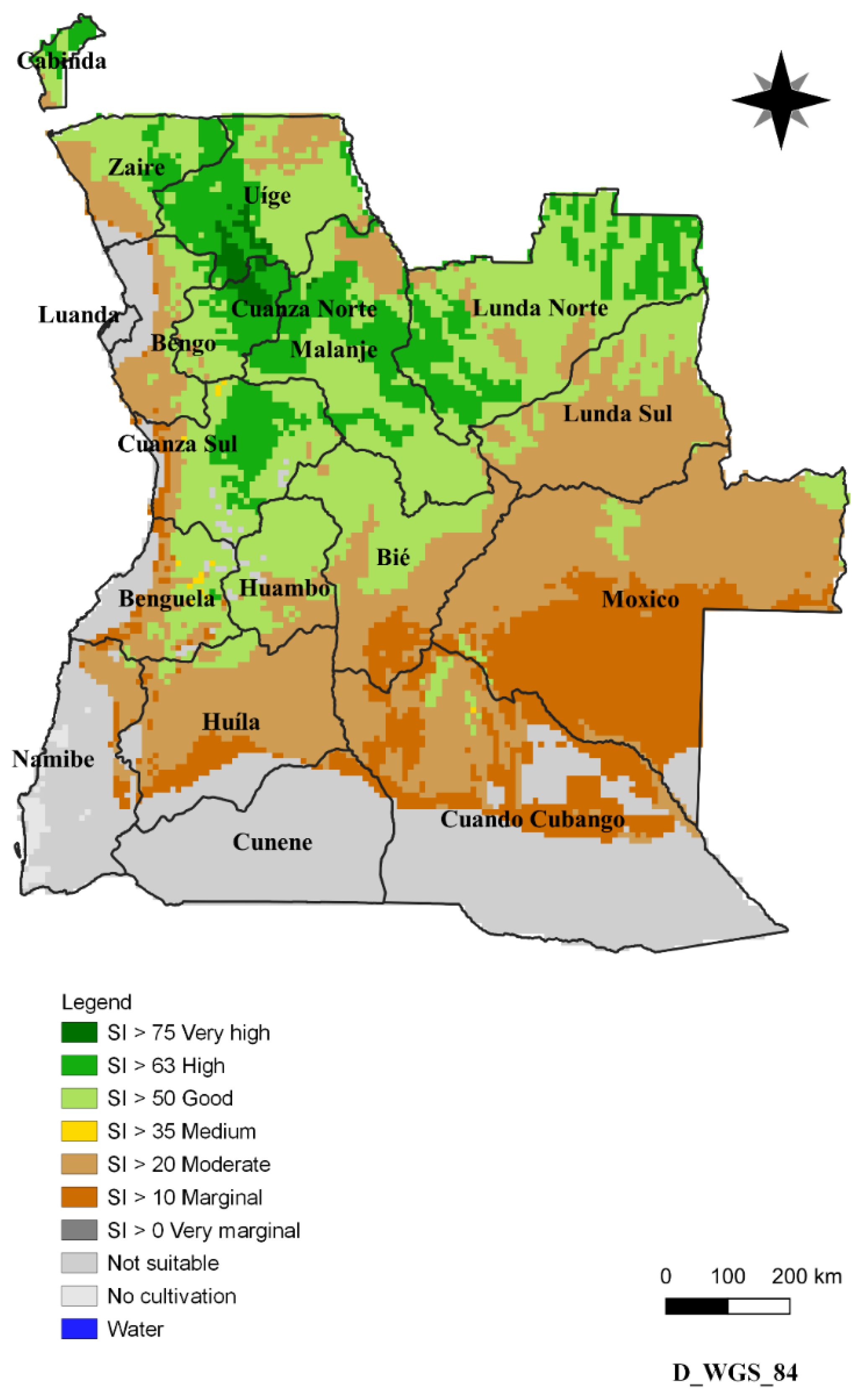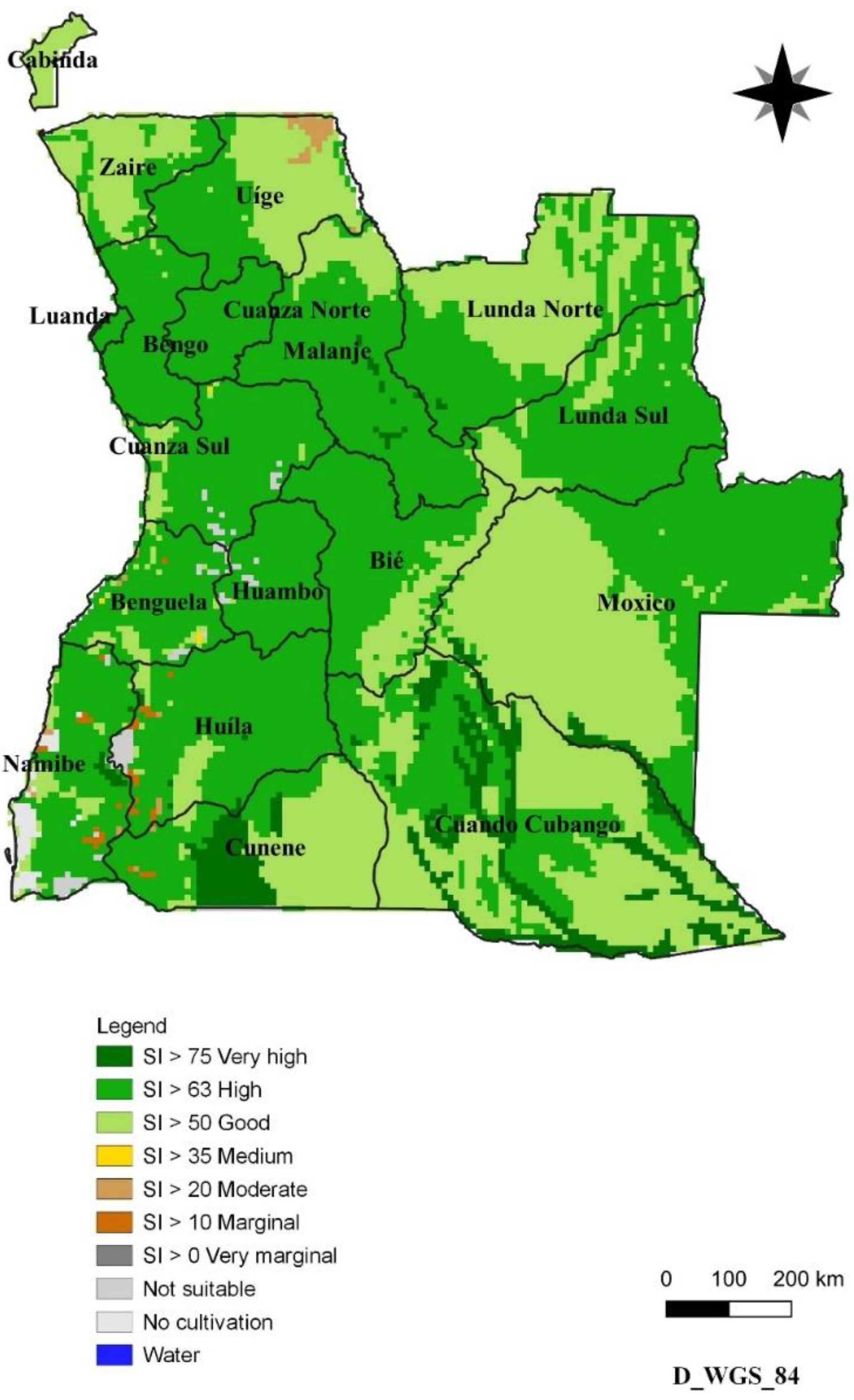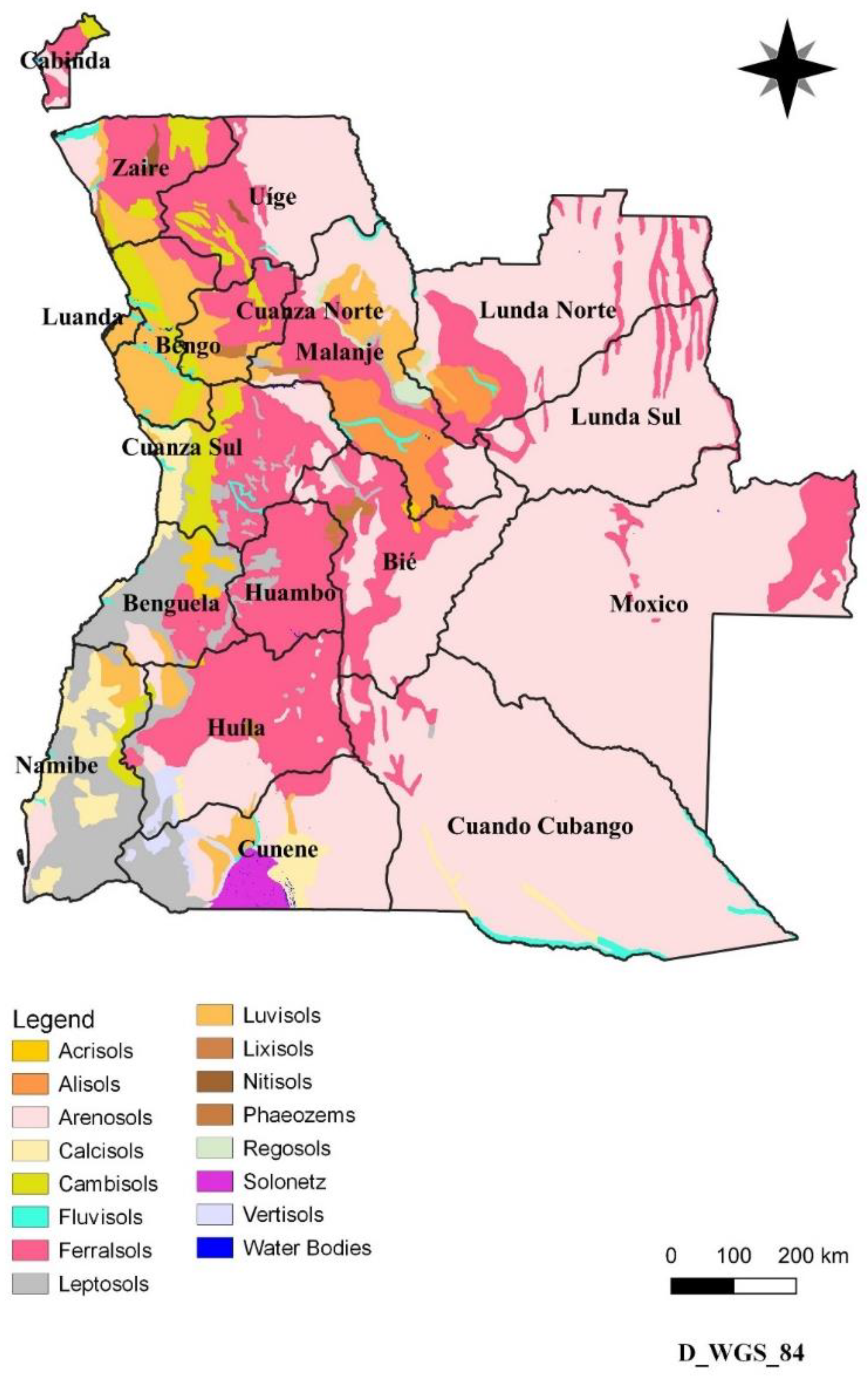1. Introduction
The consumption of sustainable bioenergy has been increasing worldwide, driving it to be one of the best alternatives to promote energy transition and decarbonization of the global energy matrix. In this sense, the IEA's projections for the evolution of global energy consumption for transport indicate that biofuels, which currently account for 4% of demand, could reach around 30% in 2050 [
1], while IRENA states that the share of biofuels is expected to grow threefold by 2030 [
2].
Bioenergy can supply different energy uses, emitting little fossil carbon, and is considered one of the most feasible types of renewable energy [
3]. Liquid biofuels are replacing fossil fuels in transportation in several countries [
4], with ethanol being particularly important, burned in blends with gasoline or pure, in more than 90 countries, in which consumption increased from 32.5 to 127.3 billion liters from 2002 to 2022 [
5]. FAO expects global ethanol fuel consumption will reach 132.4 trillion liters in 2030 [
6].
Sugarcane is one of the best crops for bioenergy production due to its high efficiency in converting solar energy into chemical energy and well-known subsequent process to produce a fuel that is easy to adopt in the circulating vehicle fleet [
7]. Sugarcane bioenergy can be cost-competitive, promote human development, and meet strict sustainability indicators, reducing greenhouse gas (GHG) emissions by approximately 80% compared to gasoline [
8]. In addition, sugarcane can face the triple challenge of energy insecurity, climate change, and rural poverty in Sub-Saharan Africa [
9,
10].
Approximately 96.6 million ton of sugarcane are produced annually in Africa, mainly in South Africa (19.5%), Nigeria (1.6%), Egypt (15%), and Ethiopia (1.4%) [
11]. Despite the existence of suitable areas for sugarcane cultivation in African countries, the overall potential of countries is varied and depends on specific agricultural and economic issues. The Southeast region has the greatest potential for rainfed sugarcane production, with additional potential for cultivation with irrigation [
12].
However, most studies on the potential of biomass as a renewable energy resource in Africa address superficially the geographical suitability of bioenergy [
13,
14,
15] or develop an overview of the potential energy supply [
16,
17,
18]. There is a lack of research quantifying the capacity to replace the current and future uses of traditional biomass and fossil fuels, or even to expand access to electricity according to current and projected demand. This question inspired the present study, which focused on Angola.
Angola has excellent conditions for the development of sustainable systems for the production and use of biofuels and bioelectricity, due to its suitable climate, availability of water resources, and land suitable for the expansion of bioenergy crops, without affecting agricultural production for domestic consumption and export, and without occupying forest or protected areas. However, it is important that such production occurs under sustainable conditions, preserving natural resources, and without negatively impacting food production, and a careful assessment of land use is indispensable.
Given this, the evaluation of the areas available for cultivating and producing bioenergy from any crop must take into account the suitability of an area considering its physical characteristics, such as precipitation, temperature, availability of water resources, and type of soil [
7]. In light of the above, the present study applies agroecological zoning, which is the ideal methodology to define the suitability, production potential, and environmental impacts linked to a study area [
19]. Therefore, the present research focuses on the quantitative evaluation of the potential for sustainable sugarcane production for bioenergy, which involves soil cover analysis, the exclusion of protected areas, as well as slope classes. However, the study also includes analyzing qualitative aspects to distinguish the areas that are effectively suitable and available for sugarcane culture to produce biofuels, aiming to estimate the potential for producing bioenergy in selected areas.
1.1. Angola Overview
Angola is located on the coast of Southern Africa, with a territorial extension of approximately 125 million hectares (Mha) divided into 18 provinces (
Figure 1), with an estimated population of 33 million inhabitants. About one third of Angola's population live in rural areas. The expanding urban areas contrast with large sparsely populated areas, especially in the provinces located along the country's coast [
20].
In 2002, Angola emerged from 27 years of civil war that devastated the country after independence and left much of its infrastructure destroyed or damaged, and most of its population displaced. Much of the existing infrastructure was built well before independence, which took place in 1975. Angola is potentially one of the richest countries in the world in mineral and natural resources [
21]. Oil production and its supporting activities contribute to approximately 50% of GDP, more than 70% of government revenues, and more than 90% of the country's exports [
20,
22] The unemployment rate in Angola reaches almost half of the population, and approximately 70% of Angolans live below the poverty line (with less than US
$ 2 per day), with poverty being more prevalent in rural areas (58%) than in urban areas (19%) [
20]. Rapid industrialization and urbanization have led Angola to become a major consumer of energy, and its energy expansion has caused much concern [
23].
Access to energy is a particular difficulty in Angola. Around 46% of the population has access to electricity, corresponding to 61% in urban areas and drops to 6.2% in rural areas. Besides, the supply has not been reliable as blackouts occur frequently. More than half of the population, i.e. 18.3 million Angolans, do not have access to electricity [
24]. Angola's electricity is generated essentially by hydropower plants (61%) and thermal plants burning oil products (38%). New renewables, such as wind, solar, and bioenergy represent less than 1% of the energy consumed in the country [
20,
25]. It is estimated that 58% of the energy used by the population for cooking comes from biomass (
Figure 2), mainly in rural areas, where most of the country's poor population is concentrated [
26,
27].
For the Angolan government, the energy sector is seen as essential for improving the country's socio-economic situation, and investments in bioenergy seem attractive [
21]. By introducing bioenergy, in addition to energy security, it would provide access to energy services without adverse impacts on health and the environment, and income-generating activities for the poor, which could alleviate poverty [
13]. Specifically, the production of ethanol from sugarcane is considered a way to reduce dependence on oil revenues and make Angola self-sufficient in energy. The potential use of electricity from sugarcane bagasse can serve as an incentive for the implementation of bioenergy and mitigate energy poverty in the Angolan electricity sector.
In 2015, the Angolan government implemented the National Strategy for Renewable Energy. This strategy seeks to contribute to the National Energy Security Policy and Strategy, by promoting the diversification of the national energy matrix, as well as the Integrated Rural Development and Poverty Fighting Programme, and to the promotion of growth and employment. In the international context, this strategy contributes to the fight against climate change and is articulated with Angola's participation in SADC (Southern Africa Development Community) and IRENA (International Renewable Energy Agency) [
28].
Angola has an abundance of arable land, freshwater, and a diversity of climate conditions suitable for the production of a variety of agricultural products, including sugarcane, but this potential is underutilized [
29]. Given its potential for promoting bioenergy, the objective of this study was to evaluate the availability of suitable land and the production of sugarcane, which is highly efficient in the conversion of solar energy into biomass for sustainable ethanol production and electricity generation in Angola.
As follows, the methodology for this assessment is introduced, the main data sources and the computational tool used, as well as the scenarios studied, and the criteria adopted for land suitability. Finally, the results are introduced and discussed.
2. Materials and Methods
The materials and methods of this research is depicted in a flowchart (
Figure 3) to visualize how the results were achieved. First, the existing literature about bioenergy was evaluated, with a focus on biofuels. Therefore, the data collection, processing, and analysis of the study are divided into two sections. In the first section, the GAEZ (Global Agro-Ecological Zones) database and the QGIS (Quantum GIS) software were used to evaluate land available for sugarcane in Angola. In the second section, the FAOSTAT database was used to complement data that could not be obtained in the first section. Areas with different restrictions were successively eliminated to obtain a pool of land available for the sustainable expansion of sugarcane. Protected areas, cultivated areas by other crops, as well as areas unsuitable for sugarcane cultivation, were excluded. Finally, an agricultural productivity model was used to estimate the yield potential of sugarcane in the respective available areas as a function of climate parameters. The outcome of this analysis is the potential amount of sugarcane available annually, which is evaluated as ethanol and electricity possible to be produced with current technology.
2.1. Databases and Computational Tools Employed
2.1.1. Global Agro-Ecological Zones (GAEZ)
The agroecological zoning methodology was developed by the Food and Agriculture Organization of the United Nations (FAO) and the International Institute for Applied Systems Analysis (IIASA) over the last 30 years. In its more recent version, GAEZ v4 is based on well-established land assessment principles to evaluate natural resources and identify appropriate agricultural land use options. It identifies resource constraints and opportunities based on the ecophysiological characteristics of plants, soil, and climate requirements of crops and uses them to assess suitability and production potentials for individual crop types under specific input and management conditions, classifying areas into six different levels from Very Suitable (VS) to Not Suitable (NS), as shown in
Table 1. According to GAEZ, total suitability of the land and cultivated areas can be summarized by the Suitability Index (SI), which ranges from SI=0 (totally unsuitable conditions) to SI=100 (the best conditions for a given culture), reflecting the expected productivity of a pixel of land, as indicated in
Table 1 [
19].
Results are given in categories of land use, impacts of climate change on crop production potential, and irrigation water needs for current and future climates. For Angola, the sugarcane production potential was estimated for the reference climate (period 2011-2040).
2.1.2. Global Food and Agriculture Statistics of FAO (FAOSTAT)
This large database provides access to food and agriculture data for over 245 countries and territories and covers all activities of the Food and Agriculture Organization of the United Nations, collected since 1961, including land cover and use, agricultural activities (annual, permanent), inputs consumption, irrigation, production volume, prices and trade, environmental impacts and constraints, sustainability, and SDG indicators.
2.1.3. QGIS Software
In this study, the geographic information software QGIS-Białowieża (version 3.22.5) has been used, which allows users to create, edit, view, analyze, and publish georeferenced map information. This software was used to process data and vector layers obtained from GAEZ, to process and display data results, such as Land Cover Maps, Digital Elevation Models, and calculation of areas in the region of interest, in the frame of the Angolan territory, which administrative maps were obtained from the Global Administrative Areas database, GADM, July 2015, in version 2.5. [
30].
2.2. Scenarios Studied and Minimum Suitability Index
To evaluate the suitability of sugarcane culture in the Angolan territory, two scenarios were studied: under rainfed conditions and irrigation conditions. Considering the SI for sugarcane, it was assumed that the area for implementing this culture, both under rainfed and irrigation conditions, to be adopted in the bioenergy production scenarios would be only those with SI > 75 (Very suitable and top quality suitable), i.e., only land with high potential for sugarcane.
2.3. Restrictions
Sugarcane expansion areas must comply with sustainability and current legislation, especially regarding areas designated by law for environmental conservation. GAEZ respects landmarks with protected status or with recognized biodiversity value. Therefore, area exclusions were made to estimate the land available for sugarcane production in Angola. Many of these exclusions may be related to soil and climate conditions. Assessing the current land cover was essential for sustainable land management, to obtain information for the planning, development, and management of the Angolan territory.
The first screening considered the protection of biodiversity in sugarcane production, excluding protected areas, as indicated by the International Union for Conservation of Nature and other sources. The second screening excludes the current cultivated area of sugarcane and other temporary and permanent crops. Even though they were not considered unsuitable, areas with sugarcane were excluded at this stage of the study, as the objective of the study is to seek new frontiers for expansion.
The third screening focused on topography, aiming to protect the soil and reduce the risk of erosion. Sloping terrain is subject to higher rates of water runoff and soil erosion, and it is generally understood that the steeper the slope, the greater the restriction on productivity potential, especially relevant when considering mechanized cultivation [
19]. Although sugarcane has been cultivated in some countries in lands with slopes up to 30% and even higher, a maximum slope of 16% was considered a safe suitability criterion for sugarcane cultivation in this study.
2.4. Sugarcane Yield Model and Bioenergy Potential
Assuming that the GAEZ takes into account the soil fertility requirement for sugarcane culture, to estimate the productivity potential of sugarcane under appropriate agricultural practices in different climatic conditions, it was adopted the model presented by [
31], applied in sugarcane plantations in Southern Africa, considering the effects of climate:
where:
Y = Average yield of sugarcane stalks [t/ha]
DD = Degree Days for temperature based on 20 ºC [ºC-day]
HD = Annual hydric deficiency for 100 cm depth [mm]
The theoretical energy potential of sugarcane and its associated annual GHG mitigation were estimated based on the ethanol and electricity potential production from sugarcane annually produced in Angola, under the following assumptions, reflecting the current state-of-art in modern sugarcane agroindustry:
Ethanol production from direct sugarcane juice: 85 L/t of sugarcane [
31].
Electricity surplus generation: 185 kWh/t, as observed in cogeneration schemes burning bagasse from mills and 40% sugarcane straw from harvest without preharvest burning and adopting high-quality live steam conditions (65 bar/485 °C) [
31].
Life Cycle Analysis (LCA) emission factors of gasoline and anhydrous ethanol assumed respectively as 86.4 and 21 gCO2-eq/MJ [
32].
LCA emission factors for power generation by diesel and natural gas adopted as 829 and 518 gCO2-eq/kWh, respectively [
33].
LCA emission factor for generating electricity using sugarcane bagasse and straw assumed as 227 gCO2-eq/kWh [
34].
Lower Heating Value (LHV) of gasoline and anhydrous ethanol, as 32.10 MJ/L and 22.30 MJ/L respectively [
35].
3. Results and Discussion
This section presents the main data on land use in Angola and the areas estimated as suitable and with potential for sugarcane cultivation and their production potential. The current coverage of Angolan territory is depicted in
Figure 4 and
Table 2, confirming the great importance of forests and wooded lands, about 61% of the national territory. On the contrary, a relatively small area is dedicated to agriculture.
Figure 5 and
Table 3 show the percentages of the protected areas, totaling approximately 13.2 Mha, which represents around 11% of Angola's territory (The percentages in all tables are related to the national land).
The area currently planted with sugarcane and other crops was obtained from FAOSTAT [
36]. These areas were identified to ensure that the additional production of sugarcane does not affect the country's current level of agricultural production. The actual area with sugarcane in Angola is estimated at 20,000 ha, with a production of 951 kt/year. The land suitable for agriculture in Angola accounts for 57 Mha, which represents 45.7% of the country's total land, of which only 14.3 Mha are in activity; areas that have been excluded represent almost 11.4% of the country's area (
Table 4).
As mentioned in the Methodology section, a maximum slope of 16% was adopted as a criterion of suitability for sugarcane cultivation, resulting in a total of 37.7 Mha, representing approximately 30% of the country's area (
Figure 6).
In synthesis, from the country's total area, around 125 Mha, approximately 60 Mha (48%) can be considered without strong restrictions and, in principle, is available for sugarcane focusing on bioenergy production. The next topics explore additional constraints, related to water availability for irrigation needs, and productivity levels.
3.1. Sugarcane Suitability in Rainfed Conditions
The suitability for growing sugarcane under rainfed conditions varies substantially between the country's regions, with prime and good land for rainfed sugarcane largely concentrated in the northern and eastern parts of the country (
Figure 7). When considering just rainfed cultivated land, the GAEZ results (
Table 5) show that approximately 0.6% of Angola's territory is prime land, with a high production potential, 35% of the territory represents good land with an average yield for sugarcane cultivation and 42% of the country's area is poor land with a low yield for sugarcane cultivation. The good to very high SI land corresponds to 44.8 Mha.
3.2. Suitability of Sugarcane under Irrigated Conditions
With irrigation (
Figure 8) the suitability of sugarcane cultivation is improved, including areas with low rainfall rate and significantly increasing land for expansion of sugarcane cultivation for bioenergy purposes. From the results obtained from the GAEZ assessment, approximately 6.3 Mha (5%) of prime land for irrigated sugarcane cultivation, 117 Mha (94%) of good land and 1.7 Mha (1%) of poor land with low yield/potential for irrigated sugarcane cultivation were identified (
Table 6). Therefore, with regards to the rainfed land, irrigation increased in 275% of the potential land for sugarcane in Angola.
3.3. Rainfed vs. Irrigated Conditions
Considering
Table 5 and
Table 6, as the land for sugarcane expansion for both conditions would be high-quality land with high potential, i.e., Very Suitable (SI>75), approximately 0.7 Mha would be land for sugarcane cultivation under rainfed conditions, which would not be viable due to the terrain conditions. The areas suitable for dry farming are concentrated in the provinces of Uíge and Cuanza-Norte, which represent mostly non-mechanizable areas (slopes above 16%), that have been excluded from the availability of land for sugarcane cultivation.
On the other hand, 6.3 Mha (SI>75) of land suitable for growing irrigated sugarcane has been identified in seven provinces of the country with characteristics and availability for the introduction of sugarcane bioenergy. The area currently planted with sugarcane in Angola represents 0.3% of the potential area estimated under irrigated conditions in this research, i.e., that area identified as suitable and available for irrigated sugarcane in Angola is 315 times larger than the area currently used to grow sugarcane.
Although sugarcane is relatively more efficient in water use than most other plants, enough water is essential to improve sugarcane yields. Angola has a large hydrological network, with 6,152 rivers spanning 154,035 km in length, providing considerable water flow rate and, in principle, the regions suitable for irrigated sugarcane have compatible water resources, according to the results obtained by [
37], [
14] and the MINEA projections [
28] on irrigation. Nevertheless, a detailed evaluation of water resources availability is essential before considering any area as effectively available for promoting irrigated sugarcane culture.
3.4. Distribution of Prime Land and Production Model by Province
Disregarding logistics constraints, seven provinces have the best potential areas (top-quality land) for expanding sugarcane production under irrigated conditions (
Table 7). Particularly the provinces of Cuando Cubango and Cunene in the Southern Angola present 5.34 Mha very suitable, which means 85% of identified best land for sugarcane in this country, corresponding to 11.9% of both provinces and 4.3% of national area. Jointly, these provinces have about 1.54 million inhabitants, less than 5% of Angolan population, mostly dedicated to subsistence rural activities such as livestock breeding, charcoal production, and the cultivation of vegetables [
38]. In this context, projects to grow and process sugarcane, properly designed and implemented, can promote sustainably the regional economy. Other provinces with suitable areas have larger population [
39].
From the slope map (
Figure 6), it is evident that the selected areas for sugarcane cultivation are within favorable slope ranges for implementing irrigation systems and introducing mechanized harvesting: Cuando-Cubango (0.5-2% slope grade), Cunene (0.5-2%), Huíla (2-5%), Lunda-Norte (2-5%), Malanje (2-5%), Moxico (0.5-2%) and Namibe (2-5%).
The fertility of the soil is determined by its physical and chemical properties for optimal use and production of crops. In [41], the reference soils suitable for planting sugarcane, are Ferralsols, Arenosols, Nitisols, and Acrisols. In the provinces of Huíla and Malanje, the high-potential soils are mainly Latosols; they are deep, porous, well-drained, and permeable, even when very clayey, and easy to prepare. In the provinces of Cuando Cubango, Cunene, Lunda-Norte, Moxico, and Namibe, the soils with high potential are Arenosols, with limited moisture (
Figure 9), but become productive when well managed and irrigated.
The estimated sugarcane yield depends, as previously stressed, on ensuring enough water resources. Specifically on irrigation, particularly the provinces of Cuando Cubango and Cunene encompasses an extensive network of rivers, with a good water supply as well [
40].
The production model presented in equation (1) was readily applied using available climate data. Data on climate conditions, measured in degree days, were based on the GAEZ platform. Water deficiency was assumed zero for irrigated conditions.
Table 8 summarizes the data and yield estimates for irrigated culture, as modelled for the Angolan provinces under analysis in this research.
3.5. Theoretical Bioenergy Potential and Associated GHG Mitigation from Irrigated Sugarcane in Angola
Considering the 6.26 Mha of land identified as suitable and available for expanding sugarcane under irrigation, circa 5% of Angola national land (
Table 7), and applying the yield estimates from equation (1) for irrigated conditions (
Table 8), approximately 956 million ton of sugarcane could be produced annually. Processing this amount of feedstock could be produced 81.3 billion liters of ethanol and generated 176,9 TWh of surplus electricity to the grid.
This impressive potential is even higher than the current bioenergy production from sugarcane in Brazil, where around 10 Mha are cultivated with sugarcane, basically in rainfed condition, producing annually circa 600 Mton, about 50% processed for ethanol. The better performance of Angola must be attributed to the irrigation, that allows an average yield estimated of 153 ton/ha for Angola, while in Brazil is 81 ton/ha, and the full use of sugarcane for energy assumed in this assessment.
The use of anhydrous ethanol in Angola in an E10 blend with gasoline allows to reduce the emission of about 500 ktCO2-eq/year in the transport sector. Alternatively, it is possible a higher reduction, 8.3 MtCO2-eq/year by replacing all gasoline consumed in this country in 2021 [
25]. Additionally, considering the export of surplus volume of ethanol to replace gasoline consumed overseas and assuming a 10% reduction in mitigation to compensate GHG emissions from logistics, Angolan ethanol could mitigate the emission of more 49.1 MtCO2 -eq/year abroad.
In 2021, Angola produced 16.4 TWh of electricity, with over 70% of the country's electricity consumption coming from diesel-powered thermoelectric plants [43]. If the electricity produced from bagasse were to replace the electricity currently produced by the diesel and natural gas thermoelectric plant in Angola, it could potentially avoid approximately 3.4 MtCO2-eq/year. This shift could contribute significantly to a cleaner electricity sector for Angola, a country highly reliant on fossil fuel generation. Summing up all contributions, it could be expected a total reduction of emissions up to 60.8 MtCO2-eq/year.
These figures confirm Angola's large potential for bioenergy production, as well as its relevant effect on the mitigation of GHG emissions.
5. Conclusions and Final Comments
This study was developed using an agroecological zone modeling database, taking into account recommendations focused on environmental preservation and sustainability of biofuel production. The results of the assessment of land suitability for sugarcane cultivation in Angola indicated that there is substantial potential to expand sugarcane bioenergy production. The growth of agricultural production in Angola can be accompanied by an expansion in the production of biofuels from sugarcane, helping to mitigate CO2, both in the electricity sector and in transportation, as well as helping the country to diversify its energy matrix.
As main results, around 6.3 Mha of land suitable for growing irrigated sugarcane has been identified, around 5% of the Angolan territory, distributed across seven provinces in the country with characteristics and availability for the introduction of sugarcane bioenergy. In this area, Angola could produce approximately one billion ton of sugarcane annually, feedstock amount large enough to produce ethanol to replace all gasoline domestically consumed and trade relevant surplus, generate ten times the current electricity consumption, and thus promoting important reduction in GHG emission.
This assessment in Angola presented results like other countries in the African Southern countries with low liquid fuel consumption and large land availability, indicating that sugarcane expansion has a high potential to replace fossil fuels with active bioenergy programs, without compromising biodiversity and water use [
9]. In Mozambique, for example, at least 33 Mha are considered to have a good potential for promoting sugarcane expansion with high productivity [44].
The authors expect that this research will be useful for promoting bioenergy projects in Angola, as well as being used as a tool for sustainable energy planning in this country and other with similar conditions and prospects.
Author Contributions
Conceptualization, Nogueira L.A.H, Matias A.J. and Ocampo E.A.B.; methodology, Matias A.J. Ocampo E.A.B. and Nogueira L.A.H; software, Matias A.J; formal analysis, Matias A.J; investigation, Matias A.J; data curation, Matias A.J. Ocampo E.A.B. and Nogueira L.A.H; writing—original draft preparation, Matias A.J; writing—review and editing, Nogueira L.A.H and Ocampo E.A.B. All authors have read and agreed to the published version of the manuscript.
Funding
This research received no funding.
Conflicts of Interest
The authors declare no conflicts of interest.
References
- IEA Bioenergy The Role of Renewable Transport Fuels in Decarbonizing Road Transport Scenarios and Contributions. AMF Annex 58/IEA Bioenergy Task 41 2020.
- IRENA World Energy Transitions Outlook 2022; 2022; ISBN 9789292603342.
- Huang, J.; Khan, M.T.; Perecin, D.; Coelho, S.T.; Zhang, M. Sugarcane for Bioethanol Production: Potential of Bagasse in Chinese Perspective. Renew. Sustain. Energy Rev. 2020, 133, 110296. [CrossRef]
- Gilani, H.; Sahebi, H.; Oliveira, F. Sustainable Sugarcane-to-Bioethanol Supply Chain Network Design: A Robust Possibilistic Programming Model. Appl. Energy 2020, 278, 115653. [CrossRef]
- Karp, S.G.; Medina, J.D.C.; Letti, L.A.J.; Woiciechowski, A.L.; de Carvalho, J.C.; Schmitt, C.C.; de Oliveira Penha, R.; Kumlehn, G.S.; Soccol, C.R. Bioeconomy and Biofuels: The Case of Sugarcane Ethanol in Brazil. Biofuels, Bioprod. Biorefining 2021, 15, 899–912. [CrossRef]
- OECD OECD-Ilibrary Available online: https://www.oecd-ilibrary.org/agriculture-and-food/data/oecd-agriculture-statistics_agr-data-en (accessed on 20 February 2024).
- Cherubin, M.R.; Carvalho, J.L.N.; Cerri, C.E.P.; Nogueira, L.A.H.; Souza, G.M.; Cantarella, H. Land Use and Management Effects on Sustainable Sugarcane-Derived Bioenergy. Land 2021, 10, 72. [CrossRef]
- Nogueira, L.A.H.; Souza, G.M.; Cortez, L.A.B.; de Brito Cruz, C.H. Biofuels for Transport. Futur. Energy Improv. Sustain. Clean Options Our Planet 2020, 173–197. [CrossRef]
- Souza, S.P.; Nogueira, L.A.H.; Watson, H.K.; Lynd, L.R.; Elmissiry, M.; Cortez, L.A.B. Potential of Sugarcane in Modern Energy Development in Southern Africa. Front. Energy Res. 2016, 4. [CrossRef]
- Marti, L.; Puertas, R. Sustainable Energy Development Analysis: Energy Trilemma. Sustain. Technol. Entrep. 2022, 1, 100007. [CrossRef]
- OECD OECD Data Explore Available online: https://data-explorer.oecd.org/ (accessed on 20 February 2024).
- Dahunsi, S.O.; Fagbiele, O.O.; Yusuf, E.O. Bioenergy Technologies Adoption in Africa: A Review of Past and Current Status. J. Clean. Prod. 2020, 264, 121683. [CrossRef]
- Fertahi, S.; Elalami, D.; Tayibi, S.; Taarji, N.; Lyamlouli, K.; Bargaz, A.; Oukarroum, A.; Zeroual, Y.; El Bouhssini, M.; Barakat, A. The Current Status and Challenges of Biomass Biorefineries in Africa: A Critical Review and Future Perspectives for Bioeconomy Development. Sci. Total Environ. 2023, 870, 162001. [CrossRef]
- Watson, H.K. Potential to Expand Sustainable Bioenergy from Sugarcane in Southern Africa. Energy Policy 2011, 39, 5746–5750. [Google Scholar] [CrossRef]
- IEA Bioenergy Implementation of Bioenergy in South Africa - 2021 Update. Technol. Cola 2021, 5–7.
- IRENA Agricultural Residue-Based Bioenergy: Regional Potential and Scale-up Strategies; 2023; ISBN 978-92-9260-564-3.
- Röder, M.; Chong, K.; Thornley, P. The Future of Residue-Based Bioenergy for Industrial Use in Sub-Saharan Africa. Biomass and Bioenergy 2022, 159, 106385. [Google Scholar] [CrossRef]
- Agoundedemba, M.; Kim, C.K.; Kim, H.-G. Energy Status in Africa: Challenges, Progress and Sustainable Pathways. Energies 2023, 16, 7708. [Google Scholar] [CrossRef]
- FAO; IIASA Global Agro Ecological Zones Version 4 (GAEZ V4); 2021; ISBN 9789251344262.
- MCTA NATIONALLY DETERMINED CONTRIBUTION OF ANGOLA Republic of Angola. 2021.
- Kissanga, R.; Catarino, L.; Máguas, C.; Cabral, A.I.R.; Chozas, S. Assessing the Impact of Charcoal Production on Southern Angolan Miombo and Mopane Woodlands. Forests 2023, 15, 78. [Google Scholar] [CrossRef]
- Tambari, I.J.T.; Failler, P.; Jaffry, S. The Differential Effects of Oil Prices on the Development of Renewable Energy in Oil-Importing and Oil-Exporting Countries in Africa. Energies 2023, 16, 3803. [Google Scholar] [CrossRef]
- Telly, Y.; Liu, X.; Gbenou, T.R.S. Investigating the Growth Effect of Carbon-Intensive Economic Activities on Economic Growth: Evidence from Angola. Energies 2023, 16, 3487. [Google Scholar] [CrossRef]
- ESMAP Angola | Tracking SDG 7 Available online: https://trackingsdg7.esmap.org/country/angola (accessed on 25 February 2022).
- Petroangola 58 - Relatório Do Sector Energético Angola 2021.Pdf 2021.
- Cativa Modelling the Potential Bioenergy Production from Agro-Forestry Crops and Residues in Angola. Eur. Biomass Conf. Exhib. Proc. 2018, 2018, 21–24.
- EIA Country Analysis Executive Summary: Angola. Indep. Stat. Anal. 2021, 9.
- MINEA Atlas e Estratégia Para as Energias Renováveis. 2015.
- World Bank Angola Agriculture Support Policy Review Realigning Agriculture Support Policies and Programs. 2021.
- GADM Global Administrative Areas Available online: https://gadm.org/ (accessed on 6 October 2022).
- IRENA Sugarcane Bioenergy in Southern Africa: Economic Potential for Sustainable Scale-Up; 2019; ISBN 9789292601225.
- Watanabe, M.D.B.; Chagas, M.F.; Cavalett, O.; Guilhoto, J.J.M.; Griffin, W.M.; Cunha, M.P.; Bonomi, A. Hybrid Input-Output Life Cycle Assessment of First- and Second-Generation Ethanol Production Technologies in Brazil. J. Ind. Ecol. 2016, 20, 764–774. [Google Scholar] [CrossRef]
- Miranda, M.M. de Fator de Emissão de Gases de Efeito Estufa Da Geração de Energia Elétrica No Brasil: Implicações Da Aplicação Da Avaliação Do Ciclo de Vida. Dissertação 2012, 164.
- Coelho Junior, L.M.; Da Silva Segundo, V.B.; Dos Santos, N.A.; De Medeiros, M.G.; Carvalho, M. Carbon Footprint of the Generation of Bioelectricity from Sugarcane Bagasse in a Sugar and Ethanol Industry. Int. J. Glob. Warm. 2019, 17, 235. [Google Scholar] [CrossRef]
- Pacheco, R.; Silva, C. Global Warming Potential of Biomass-to-Ethanol: Review and Sensitivity Analysis through a Case Study. Energies 2019, 12. [Google Scholar] [CrossRef]
- FAO FAOSTAT Available online: https://www.fao.org/faostat/en/#data/RL (accessed on 20 November 2021).
- Ackbar, L.S. A Land Suitability Assessment for Sugarcane Cultivation in Angola - Bioenergy Implications. 2007.
- MINPE Situação Da Insegurança Alimentar e Nutricional Aguda Nas Províncias de Cunene, Huila e Namibe Luanda, Agosto de 2021. 2021.
- Statista Angola: Population by Province 2022 | Statista Available online: https://www.statista.com/statistics/1201772/population-of-angola-by-province/ (accessed on 27 September 2022).
- INRH Mapa Hidrográfico de Angola e Hierarquização Dos Rios. 2020.
- Batlle, E.A.O.; Julio, A.A.V.; Santiago, Y.C.; Palácio, J.C.E.; Bortoni, E.D.C.; Nogueira, L.A.H.; Dias, M.V.X.; González, A.M. Brazilian Integrated Oilpalm-Sugarcane Biorefinery: An Energetic, Exergetic, Economic, and Environmental (4E) Assessment. Energy Convers. Manag. 2022, 268. [Google Scholar] [CrossRef]
- EPE Balanço Energético Nacional. 2023.
- EIA International - U.S. Energy Information Administration (EIA) Available online: https://www.eia.gov/international/overview/country/AGO (accessed on 25 February 2023).
- Leal, M.R.L.V.; Leite, J.G.D.B.; Chagas, M.F.; da Maia, R.; Cortez, L.A.B. Feasibility Assessment of Converting Sugar Mills to Bioenergy Production in Africa. Agric. 2016, 6, 1–10. [Google Scholar] [CrossRef]
|
Disclaimer/Publisher’s Note: The statements, opinions and data contained in all publications are solely those of the individual author(s) and contributor(s) and not of MDPI and/or the editor(s). MDPI and/or the editor(s) disclaim responsibility for any injury to people or property resulting from any ideas, methods, instructions or products referred to in the content. |
© 2024 by the authors. Licensee MDPI, Basel, Switzerland. This article is an open access article distributed under the terms and conditions of the Creative Commons Attribution (CC BY) license (http://creativecommons.org/licenses/by/4.0/).
